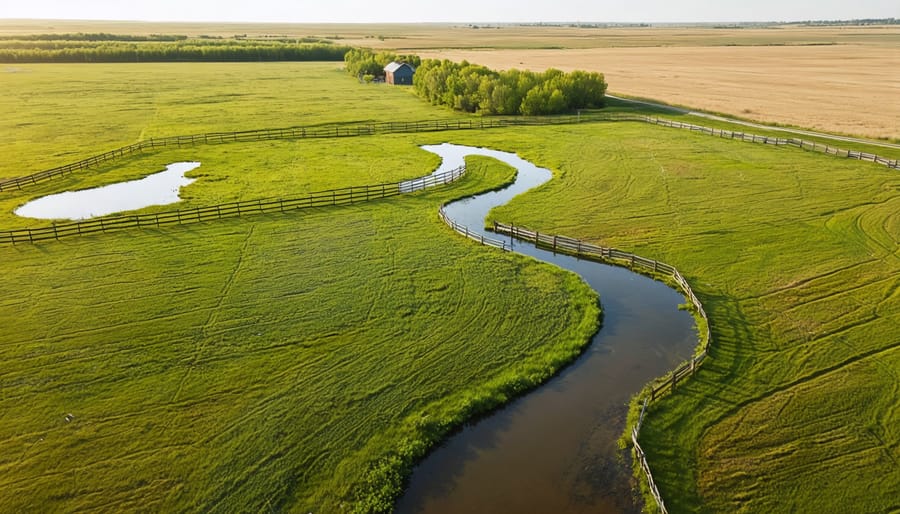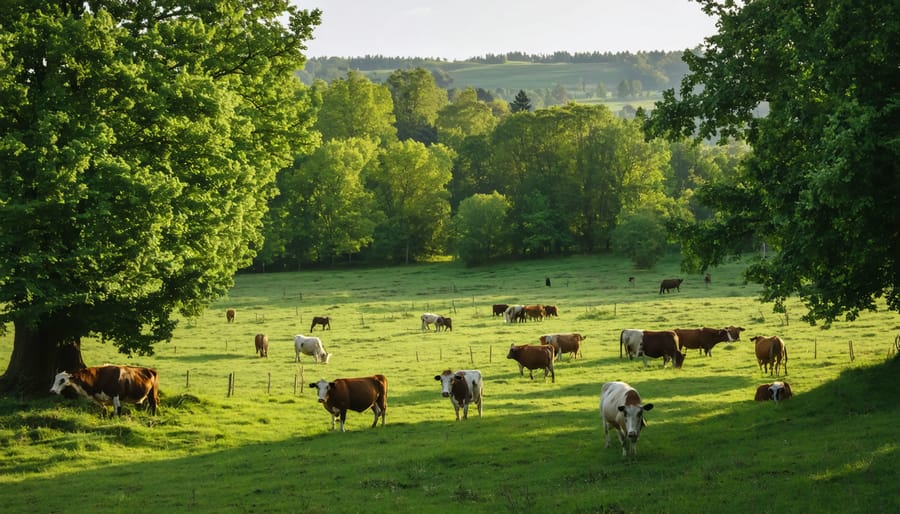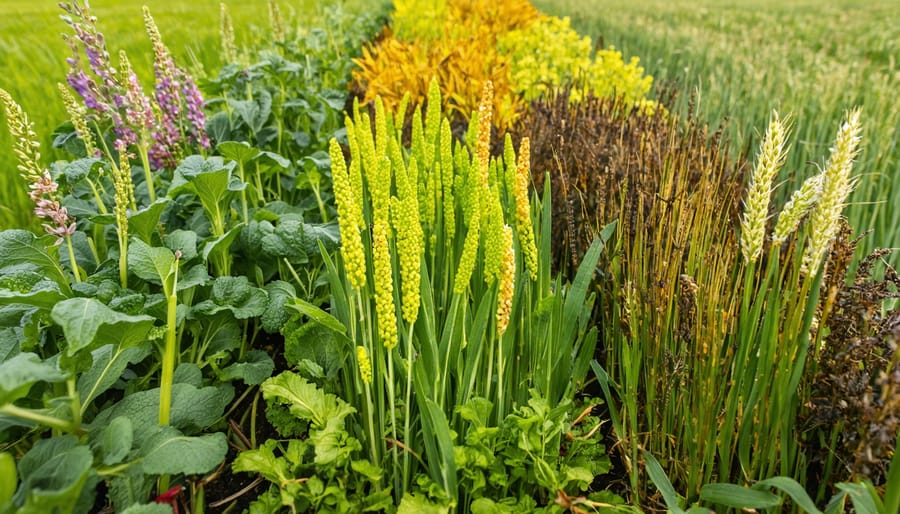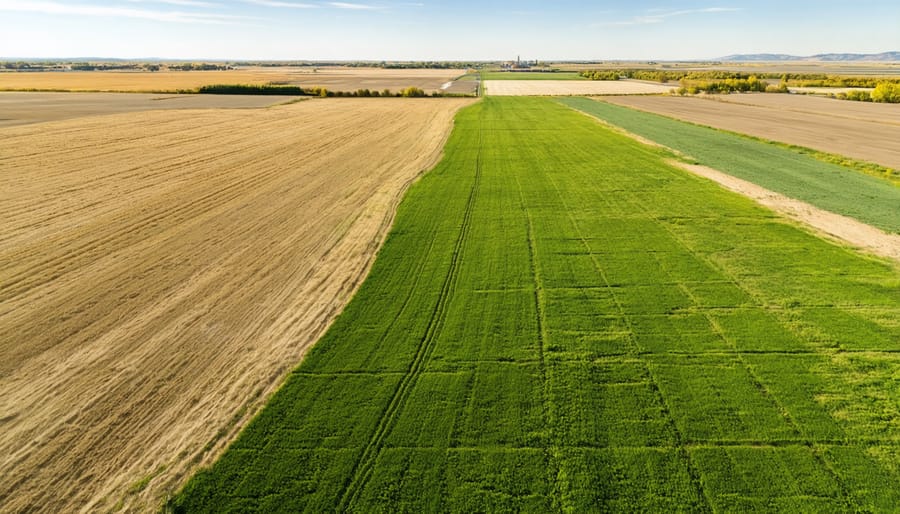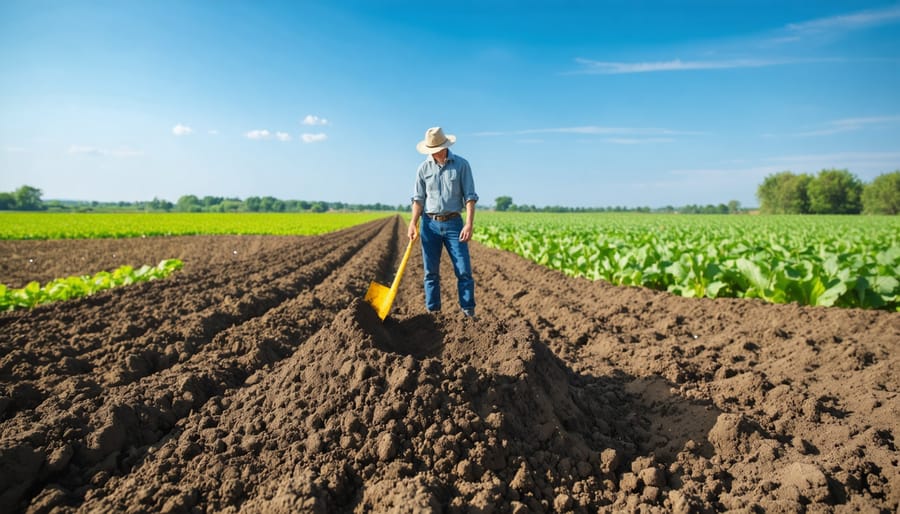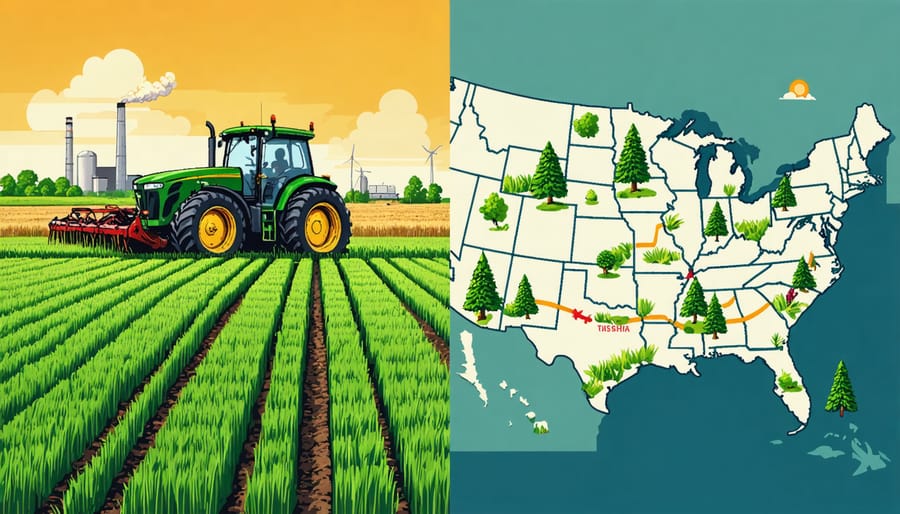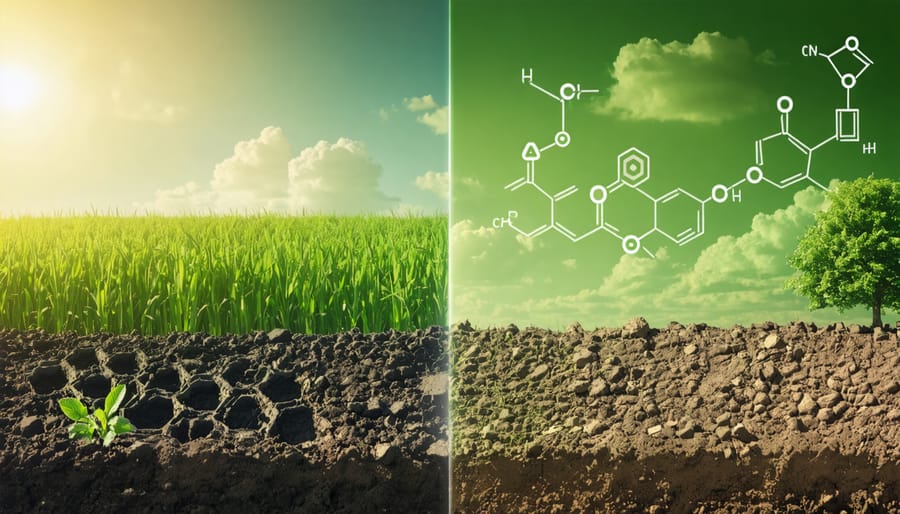Soil structure and microbiome functions are the backbone of sustainable agroecosystems. Soil health is critical for optimizing crop yields, enhancing nutrient cycling, and building climate resilience. The complex interactions between soil physical properties, chemical composition, and diverse microbial communities drive essential processes like organic matter decomposition, nutrient mineralization, and plant growth promotion. Understanding and harnessing these intricate relationships is key to developing regenerative agricultural practices that prioritize long-term soil fertility, biodiversity conservation, and agroecosystem resilience in the face of climate change. By focusing on soil health management strategies that foster beneficial microbes, improve soil structure, and reduce reliance on synthetic inputs, we can create more productive, adaptable, and ecologically sound farming systems for a sustainable future.
Understanding Soil Structure
Physical Properties
Soil texture, aggregation, and porosity play crucial roles in soil structure and its ability to support healthy plant growth. Soil texture refers to the relative proportions of sand, silt, and clay particles, which influence water retention, nutrient availability, and root penetration. Well-aggregated soils have stable clusters of particles that create a network of pores, allowing for efficient water infiltration, drainage, and aeration. This porous structure also provides habitat for beneficial microorganisms and enables root growth. Alberta’s diverse soil types, from sandy loams to clay loams, require tailored management practices to optimize their physical properties. Practices such as reduced tillage, cover cropping, and organic matter additions can improve soil aggregation and porosity, enhancing water-holding capacity and resilience to erosion. By understanding and nurturing the physical characteristics of their soils, Alberta farmers can create a foundation for healthy, productive agroecosystems that support sustainable agriculture and contribute to climate resilience.

Chemical Properties
Soil chemical properties play a crucial role in the health and productivity of agroecosystems. The pH level of soil impacts nutrient availability, with a slightly acidic to neutral range (6.0-7.0) being optimal for most crops. Farmers can revitalize your soil by managing pH through amendments such as lime or sulfur. Nutrient availability is influenced by factors like soil texture, organic matter content, and microbial activity. Organic matter, composed of decomposing plant and animal residues, enhances soil structure, water retention, and nutrient cycling. By incorporating cover crops, compost, and reducing tillage, farmers can increase organic matter levels and support a thriving soil microbiome. These practices not only improve soil health but also contribute to climate resilience by sequestering carbon and reducing reliance on synthetic inputs.
Biological Properties
The soil microbiome, a complex community of bacteria, fungi, and other microorganisms, plays a critical role in maintaining soil health and fertility. These tiny creatures work tirelessly to break down organic matter, cycle nutrients, and support plant growth. In Alberta’s agroecosystems, a thriving soil microbiome is essential for crop productivity and resilience. By promoting beneficial microbial activity through practices like crop rotation, cover cropping, and reduced tillage, farmers can enhance soil structure, nutrient availability, and disease suppression. Investing in the health of our soil microbiome is a key strategy for building sustainable and climate-resilient agricultural systems in our region.
The Soil Microbiome
Composition and Diversity
A diverse array of microorganisms, including bacteria, fungi, protozoa, and nematodes, inhabits healthy soil. These microscopic life forms interact in complex ways to support plant growth, nutrient cycling, and disease suppression. Bacteria, the most abundant microbes in soil, play crucial roles in decomposing organic matter, fixing nitrogen, and producing antibiotics that protect plants from pathogens. Fungi, such as mycorrhizae, form symbiotic relationships with plant roots, enhancing nutrient and water uptake. Protozoa and nematodes act as predators, keeping bacterial and fungal populations in check while releasing nutrients for plant use.
The composition and diversity of the soil microbiome vary depending on factors like soil type, climate, and management practices. A rich, balanced microbial community is a hallmark of healthy soil. By nurturing this diversity through practices like crop rotation, cover cropping, and reduced tillage, Alberta farmers can promote resilient agroecosystems that are better equipped to withstand stresses and support productive crops. Understanding and harnessing the power of the soil microbiome is key to advancing sustainable agriculture in the region and beyond.
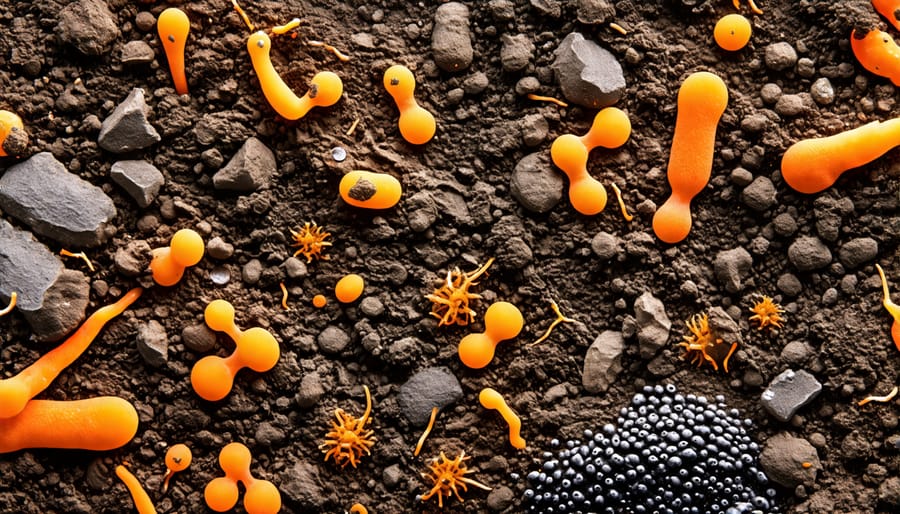
Nutrient Cycling
Soil microbes play a crucial role in nutrient cycling, transforming organic matter and making essential nutrients like nitrogen, phosphorus, and potassium available for plant uptake. Through decomposition, mineralization, and immobilization processes, microorganisms break down complex compounds and convert them into forms that plants can readily absorb. For instance, nitrogen-fixing bacteria such as Rhizobium form symbiotic relationships with legumes, converting atmospheric nitrogen into usable forms for plants. Phosphate-solubilizing bacteria and fungi help release bound phosphorus, enhancing its availability. By promoting nutrient cycling, a thriving soil microbiome improves soil fertility, reduces the need for synthetic fertilizers, and supports healthier, more resilient crops. Adopting practices like cover cropping, crop rotation, and minimizing tillage can foster a diverse and active soil microbiome, ultimately contributing to more sustainable and productive agroecosystems in Alberta and beyond.
Disease Suppression
A diverse soil microbiome plays a crucial role in suppressing plant diseases in agroecosystems. Beneficial microorganisms, such as certain bacteria and fungi, can outcompete pathogens for resources, produce antibiotics, and induce systemic resistance in plants. For example, the fungus Trichoderma harzianum has been shown to control root rot in crops like wheat and canola. Encouraging a thriving microbiome through practices like crop rotation, cover cropping, and reduced tillage can help maintain this natural disease suppression. Additionally, inoculating soils with specific beneficial microbes, like mycorrhizal fungi, can further enhance plant health and resilience. By fostering a robust soil microbiome, Alberta farmers can reduce their reliance on chemical fungicides and cultivate more resilient agroecosystems. Investing in the health of our soil is an investment in the long-term sustainability and profitability of our farms and communities.
Promoting Soil Health in Alberta Farms
Conservation Tillage
Conservation tillage practices, such as no-till and reduced tillage, offer significant benefits for soil structure and health. By minimizing soil disturbance, these practices help maintain the natural soil structure, allowing for better water infiltration, improved soil aggregation, and reduced erosion. Reduced tillage also promotes the development of a diverse and thriving soil microbiome, which is essential for nutrient cycling, disease suppression, and overall soil fertility. By adopting conservation tillage methods, Alberta farmers can not only improve their soil’s physical properties but also enhance its biological functions, ultimately leading to more resilient and productive agroecosystems. As a bonus, conservation tillage can also help reduce labor and fuel costs, making it a win-win for both the environment and the farmer’s bottom line. Ready to take your soil health to the next level? Check out our article on boosting soil health with organic no-till practices tailored for Canadian farms.
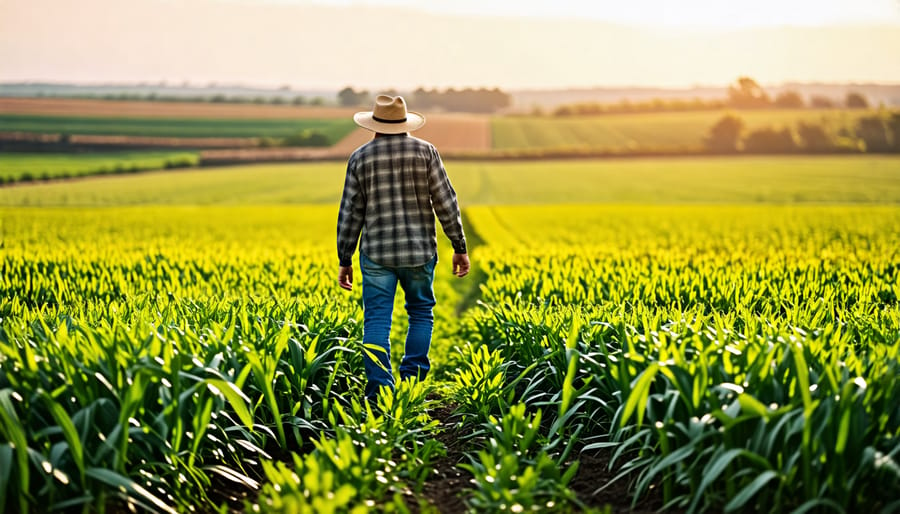
Cover Cropping
Cover cropping is a powerful strategy for enhancing soil health and nurturing a diverse microbiome in your fields. By planting cover crops between main crop rotations, you can protect and enrich the soil, leading to improved water infiltration, reduced erosion, and increased organic matter. Cover crops add diversity to the soil ecosystem, providing a variety of root exudates and plant residues that feed beneficial microorganisms. This diversity is key to building a resilient and productive soil microbiome.
Leguminous cover crops, such as clover and vetch, form symbiotic relationships with nitrogen-fixing bacteria, adding valuable nitrogen to the soil. Other cover crops, like rye and oats, have extensive root systems that help break up compacted soils, improving soil structure and aeration. As cover crops grow and eventually decompose, they contribute to the formation of stable soil aggregates, enhancing soil structure and creating a favourable habitat for microbes.
By keeping the soil covered and providing a living root system throughout the year, cover crops support the growth and activity of beneficial fungi, bacteria, and other soil organisms. This thriving microbiome helps cycle nutrients, suppress plant diseases, and improve overall soil health. Incorporating cover cropping into your farm’s management practices can lead to long-term benefits for your soil’s productivity and resilience.
Integrated Nutrient Management
Integrated Nutrient Management (INM) is a key strategy for enhancing soil health and crop productivity in agroecosystems. Organic amendments, such as compost, manure, and cover crops, play a vital role in INM by improving soil structure, increasing nutrient availability, and supporting beneficial microorganisms. These amendments add organic matter, which helps bind soil particles together, creating a more stable and porous structure that facilitates water retention and root growth.
Precision fertilization techniques, such as variable rate application and split application, allow farmers to optimize nutrient use efficiency and minimize environmental impacts. By applying nutrients based on soil test results and crop requirements, farmers can ensure that plants receive the right amount of nutrients at the right time, reducing waste and minimizing nutrient losses through leaching or runoff. This targeted approach not only improves crop yields but also helps protect water quality and reduce greenhouse gas emissions associated with fertilizer production and application.
Conclusion
In conclusion, understanding soil structure and microbiome functions is crucial for developing climate-resilient agriculture in Alberta. Healthy soils with diverse microbial communities and stable structures are the foundation of productive, sustainable agroecosystems. By adopting practices like reduced tillage, cover cropping, and crop rotation, Alberta farmers can enhance soil health, improve nutrient cycling, and bolster crop resilience to climate stressors. These strategies not only benefit individual farms but also contribute to the collective goal of building a more sustainable and resilient agricultural system in the face of climate change.
As stewards of the land, Alberta farmers have a unique opportunity to lead the way in promoting soil health and sustainable agriculture practices. By sharing knowledge, collaborating with researchers, and embracing innovative approaches, the agricultural community can work together to create a thriving, climate-resilient future for generations to come. The path to sustainable agriculture begins with the soil beneath our feet, and every farmer has the power to make a difference. Let us commit to nurturing our soils, supporting our microbiomes, and building a more resilient agricultural landscape in Alberta, one field at a time.


